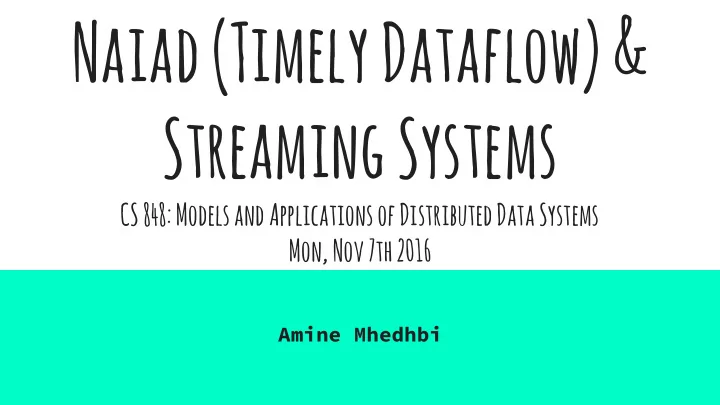

Naiad (Timely Dataflow) & Streaming Systems CS 848: Models and Applications of Distributed Data Systems Mon, Nov 7th 2016 Amine Mhedhbi
What is ‘Timely’ Dataflow ?! What is its significance?
Dataflow ?!
Dataflow?!
Dataflow?!
Dataflow?!
Dataflow?!
Dataflow?!
Dataflow?!
Dataflow Batch Processing e.g. MapReduce, Spark ● Asynchronous Processing e.g. Storm, MillWheel ● Variations for Graph Processing e.g. Pregel, GraphLab ●
Dataflow: Batch Processing
Dataflow: Batch Processing
Dataflow: Batch Processing
Dataflow: Batch Processing
Dataflow: Batch Processing
Dataflow: Batch Processing Iterations make use of synchronization. ● The cost is latency. ●
Dataflow: Asynchronous Processing
Dataflow: Asynchronous Processing Compared with batch: ● latency is lower. ○ Aggregations are incremental and data changes over time. ○ More efficient for distributed systems. ● Stages do not need coordination. ○ Correspondence between input & output is lost. ●
So, what is (Naiad) Timely dataflow ?!
Timely Dataflow?!
Timely Dataflow Reconcile both models batch and async. ● Low-latency and high-throughput. ●
Where does Naiad fit?!
Naiad?! It is the prototype built by Microsoft Research ● underlying Timely dataflow Computational model. Iterative and incremental computations. ● The logical timestamps allow coordination . ● Provides efficiency, maintainability and simplicity. ●
Let’s look at a computational example
Naiad?! It is the prototype built by Microsoft Research ● underlying Timely dataflow Computational model.
The Timely Dataflow Graph Structure
Graph Structure
Graph Structure
Graph Structure
Graph Structure input comes in as (data, 0), (data, 1), (data, 2) ● Within a loop, I adds a loop counter so it is (data, epoch, 0) ○ F in each iteration increments the loop counter (data, epoch, 1) etc. E removes the loop counter and it is back to (data, epoch)
Programming Model Using the timestamps
Programming Model
Programming Model
Programming Model
Programming Model
Programming Model
Programming Model Summary SendBy(edge, message, timestamp) ● OnRecv(edge, message, timestamp) ● NotifyAt(timestamp) ● OnNotify(timestamp) ●
Programming Model In Practice
Notice Project was discontinued in 2014. ● Silicon Valley lab closed. The paper uses C#. ● The latest one is open sourced and is in Rust.
Word Count Example Class V<Msg, Time>: Vertex<Time> { ... }
Word Count Example { Dict<Time, Dict<Msg, int> > counts; ... }
Word Count Example (2 Different Implementations) { void OnRecv (Edge e, Msg m, Time t) { ... } void OnNotify (Time t) { ... } }
Writing Programs in General It is possible to write programs against the Timely ● Dataflow abstraction. It is possible to use libraries (MapReduce, Pregel, ● PowerGraph, LINQ etc.) In General: ● Define Input, computational & Output vertices. ○ Create a timely dataflow graph using the appropriate interface. ○ Supply labeled data to input stages. ○ Stages follow a push-based model. ○
Timely Guarantees
How is timely dataflow achieved
How is timely dataflow achieved Key point : timestamps at which future message can occur ● depends on: 1. Unprocessed events & 2. Graph Structure.
How is timely dataflow achieved Pointstamp of an event (timestamp, location: E or V) ● SendBy -> Msg event of pointstamp (t, e) ○ NotifyAt -> Notif event of pointstamp (t, v) ○
How is timely dataflow achieved Pointstamp(t1, l1) could-result-in Pointstamp(t2, l2) ● If there is a path between l1 and l2 presented by f() i.e. f(t1) <= t2
How is timely dataflow achieved (Correctness Guarantees) Path Summary between A and C: “” ●
How is timely dataflow achieved (Correctness Guarantees) Path Summary between A and C: “add” or “add-increment(n)” ●
Single-Threaded Implementation Scheduler that needs to deliver events. ●
Single-Threaded Implementation Scheduler has active pointstamps <-> unprocessed events. ●
Single-Threaded Implementation Scheduler has active pointstamps <-> unprocessed events. ● Scheduler has two counts: ● Occurrence count of not resolved event. ○ Precursor count of how many active pointstamps precede it in the ○ could-result-in order.
Single-Threaded Implementation Pointstamp(t, l) becomes active . ● Precursor count to number of existing active pointstamps that could result in it. Increment precursor count of any pointstamp it could-result-in. Becomes not active when occurrence is zero. When not active, decrement the precursor count for any pointstamp that it could-result-in.
The Distributed Environment
Distributed Implementation
Distributed Progress Tracking Initial protocol: same as single multi-threaded. ● Broadcast occurrence count updates. ○ Do not immediately update local occurrence count. ● Broadcast progress updates to all workers including myself. ○ Broadcast from a worker to another delivered in a FIFO manner. ○ Use of a projected timestamp. ● A technique to buffer and accumulate updates. ●
Micro-Stragglers Have a big effect on overall performance. ● Packet Loss (Networking) ○ Contention on concurrent data ○ Garbage collection ○
Performance Evaluation
Performance Evaluation I invite you to read: “Scalability! BUT at what Cost” ●
Performance Evaluation Comparison with: ● SQL Server Parallel Data Warehouse (RDBMS) ○ Scalable HyperLink Store ( distributed in-memory DB for storing large ○ portions of the web graph) DryadLINQ (data parallel computing using a declarative / high level ○ programming language) Algos i.e. PageRank, SCC etc. ●
Conclusion: “Our prototype outperforms general-purpose batch processors and often outperforms state-of-the-art async systems which provide few semantic guarantees.”
Conclusion: “Our prototype outperforms general-purpose batch processors and often outperforms state-of-the-art async systems which provide few semantic guarantees.”
Streaming Systems as of today
Streaming Systems Systems that have unbounded data in mind. ● They are a superset of batch processing systems. ●
Streaming Systems Reference: Fig-1: Example of time domain mapping. Streaming 101
Streaming Systems Design Questions: ● What results are calculated? The types of transformations within the pipeline. ● Where in event time are results calculated? The use of event-time windowing within the pipeline. ● When in processing time are results materialized? The use of watermarks and triggers. ● How do refinements of results relate? Discard or accumulate or accumulate and retract .
Fin. Thank you!
Resources Link to transcribed talk in pdf format. ● Timely Dataflow (Rust Implementation) ● Frank blog posts: ● Timely dataflow ○ Differential dataflow ○ The world beyond batch: Streaming 101 ● The world beyond batch: Streaming 102 ●
Recommend
More recommend